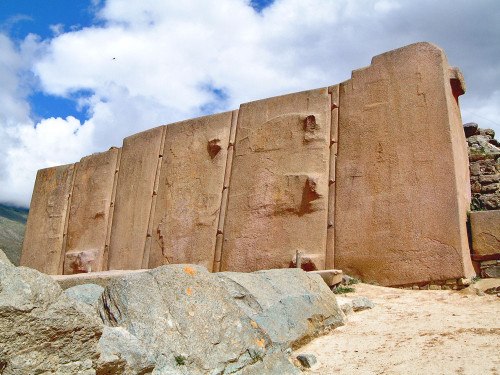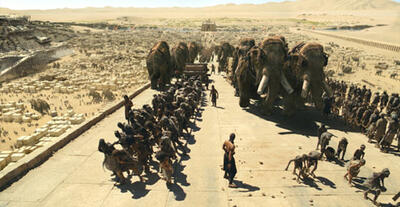Creative Speculation
Related: About this forumWere extinct Pleistocene megafauna harnessed to build the largest Neolithic monuments?
Eric Von daniken’s Chariots of the Gods fascinated me as a child, and I witnessed a compelling UFO in my 20’s, but I recognized early the general lack of critical thinking skills in the ancient alien ‘community’. That is a more benign form of the QAnon phenomenon, in my opinion, but still pernicious because it undercuts belief in science. That being said, I’m posting this as an archeology student and asking for a refutation, if you can provide it. Thanks.I visited Ollantaytambo in Peru’s Sacred valley, near Cusco, in 2015. I agree that current archeology cannot explain how the 50-100 ton monoliths at the Temple of the Sun were were moved from one mountain to the top of another.

https://uncoveredhistory.com/south-america/exploring-the-mysteries-of-the-andes/
Those stones make me wonder if extinct megafauna were used as beasts of burden and, if so, would explain why the largest stones are always the oldest and predate the Inca. Humans domesticated the camel and the elephant many thousands of years ago. No one has established with certainty how far back they were first used. There were several giant species of both in the Andes and we have very little idea about their disposition or behavior. Imagine an animal as or more biddable than a camel—bactrian or dromedary—or an Indian elephant but twice or three times the size.
There was an enormous span of time, almost 200k years, when humans and these giant mammals coexisted. It’s important to remember that climate change, not human predation, caused the mass extinction. I am confident there were talented people to work out the details if it were possible. (Catbyte posts videos of such people just about every day.)
Probably only a single species, one that was endangered already before humans made contact, or a few select individuals within that species, perhaps orphaned individuals, were suitable.
In the past few years we’ve learned that the process for canine domestication started tens of thousands of years prior to the prevailing estimates—definitely prior to the end of the Ice Age. Extinction of predators may have preceded that of non-carnivorous species, leaving a dying species a brief window, a few thousand years, with no natural predators, and selection pressures toward docility.
Direct evidence for their limited use would be extremely scarce. There must be at least one grave, though, somewhere, or ceremonial remains of consumption or cremation. The animals would have played too important a role for zero direct evidence to exist. Maybe searching for bones and graves along the most probable routes taken would find it.
Kali
(55,000 posts)Ponietz
(2,932 posts)
zuul
(14,624 posts)That's perfect!
Effete Snob
(8,387 posts)Ponietz
(2,932 posts)No other way.
To my knowledge, only one wolf/dog skull from 33,000 years ago has been found although dogs were domesticated in multiple places all over the world, were far more numerous, and didn’t go extinct.
Cave art tells me humans possessed the necessary intelligence and imagination. Paleolithic humans mastered animal husbandry. Their whole lives revolved around animals. Training a grizzly bear isn’t anything new. They used their techniques on many species. The Russian study of foxes shows they can be domesticated in just a few generations.
Is it outrageous to suggest our ancestors may have done the same with extinct species? The extinct ones may have been even MORE tractable. We don’t know. They may have been free-ranged. Again, we don’t know.
zuul
(14,624 posts)Ponietz
(2,932 posts)Glad you had a laugh. I’d appreciate a reply on the merits, though.
zuul
(14,624 posts)I'm in New Orleans, still without power after Hurricane Ida. I have many home repairs that are needed, I can't get my prescriptions filled, and I haven't had a real meal or a cold drink in 4 days. The temperature is in the 90s (well over 100 with the heat index.) All my friends and coworkers evacuated, so I'm here alone, trying to deal with a fucking tragedy.
I will fucking laugh at a post in the fucking 'creative speculation' group if I fucking want to.
Ponietz
(2,932 posts)Last edited Thu Sep 2, 2021, 04:13 PM - Edit history (1)
Didn’t mean to put you on the defensive. I hope you are safe and well, at least. Really ironic that the rain we had yesterday came from Ida and we needed it very badly.
canetoad
(17,129 posts)But you may find this interesting even though it's a couple of hundred thousand years removed from your theory.
Francis Pryor is an archaeologist specialising in the European bronze age. He questions many accepted beliefs regarding agriculture, the 'Dark Ages' the Roman occupation of Britain, with an engaging and knowledgable humour. One of his hobbies is farming ancient sheep breeds - animals that were said not to respond to herding dogs.
It's worth reading the whole article; difficult to extract a pertinent few paragraphs.
"In fact I would go further than that. My foray into farming taught me that archaeologists not only can, but must look beyond the trench, the laboratory or the library. After all, who are we doing our work for? Cambridge taught me very well how to do archaeology, but they also instilled a misplaced sense of the exclusivity of the subject. Somehow it was too important to trivialise or to take lightly; we were privileged to be given access to its sacred groves. In retrospect, what made those attitudes so hypocritical was that our Professor, Glyn Daniel, had been elected BBC TV Personality of The Year a few years previously. The prevailing view throughout the Department was that archaeology was an orthodoxy: you didn’t invite outsiders into its church. You gave them your views, as I said in a recent blog post, ex cathedra – from the pulpit. And indeed, the tradition still continues in many presenter-led TV and radio programmes."
https://digventures.com/2014/01/francis-pryor-asks-how-are-sheep-relevant-to-life-and-archaeology/
Ponietz
(2,932 posts)Last edited Sat Sep 18, 2021, 03:53 PM - Edit history (1)
I’m getting Pryor’s Making of the British Landscape. Thank you
![]()
RFCalifornia
(440 posts)They were extinct by then
The folks on Rapa Nui, for example, say the Moai "walked there" when asked about how they got the structures to where they are now
Archaeologists, using ropes, were able to get the Moai to move from side to side, as if they were walking, by taking tens of people pulling on each side in cadence
Thus they "walked there"
Ponietz
(2,932 posts)More than a year has passed since I originally posted this thread.
[link:https://www.sciencealert.com/ancient-poop-suggests-humans-tended-animals-2000-years-earlier-than-we-thought]
EX500rider
(10,791 posts)"10,000BC"

Ponietz
(2,932 posts)The idea isn’t new but I tried to argue it’s plausibility rationally.